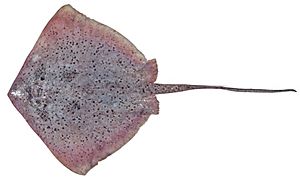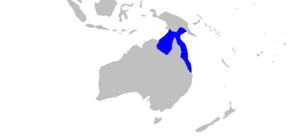Peppered maskray facts for kids
Quick facts for kids Peppered maskray |
|
|---|---|
 |
|
| Conservation status | |
| Scientific classification | |
| Genus: |
Neotrygon
|
| Species: |
picta
|
 |
|
| Range of the peppered maskray | |
The peppered maskray (Neotrygon picta), also called the speckled maskray, is a type of stingray. It belongs to the family called Dasyatidae. You can find this ray in the shallow waters off northeastern Australia.
This small ray has a thin body. It can grow up to 32 cm (13 in) wide. Its body is shaped like a diamond. It has a short, whip-like tail. The tail has folds on both the top and bottom. Its back is light yellow to brown. It has a cool speckled pattern of black spots and brownish lines.
The peppered maskray lives on the ocean floor. It likes soft, sandy places. It mainly eats crustaceans, like shrimp, and worms. Female rays give birth to one to three live young. They feed their babies with a special "uterine milk" inside them.
Even though fishing boats sometimes catch these rays by accident, they are still common. Many live in areas where fishing is not allowed. Because of this, the International Union for the Conservation of Nature (IUCN) says the peppered maskray is of Least Concern. This means it is not currently in danger.
Contents
About the Peppered Maskray
Scientists once thought the peppered maskray was just a different color version of the painted maskray. But special DNA tests showed it is its own unique species.
Two scientists, Peter Last and William White, officially described this ray in 2008. They wrote about it in a publication from the Commonwealth Scientific and Industrial Research Organisation (CSIRO). The name picta comes from a Latin word meaning "painted" or "colored." This fits its speckled look!
What Does It Look Like?
The peppered maskray has a thin body shaped like a diamond. It is about 1.2 times wider than it is long. Its front edges are slightly curved inwards. The snout (nose) is pointed. It has small eyes that are close together. Behind the eyes are crescent-shaped openings called spiracles.
Its nostrils are long. There is a skin flap between them that looks like a skirt. This flap has two small lobes. The mouth is small and has small bumps called papillae around it. There are also two papillae on the floor of its mouth. It has many rows of tiny teeth.
The ray has five pairs of S-shaped gill slits. Its pelvic fins are medium-sized and shaped like triangles.
Its Tail and Skin
The ray's tail is like a whip. It is about 1 to 1.3 times as long as its body. The tail has thin stinging spines on top. Smaller rays usually have one sting, while larger ones might have two. The tail is wide and flat at the base. It becomes very thin behind the sting.
Both the top and bottom of the tail have fin folds past the sting. The top fold is shorter than the bottom one. The ray has up to 22 small thorns along the middle of its back, behind its spiracles. Otherwise, its skin is mostly smooth.
The peppered maskray is light yellow to brown on top. It has a darker pattern of lines that can be faint or very clear. Many black spots cover its body. Like other Neotrygon rays, it has a dark mark across its eyes that looks like a mask. The tail has a pattern of stripes or bands behind the sting. The tip of the tail is white. The underside of the ray is plain white.
Where It Lives
The peppered maskray lives along the coast of northeastern Australia. You can find it from the Wessel Islands in the Northern Territory to Hervey Bay in Queensland. We are not sure how far west its home range goes. It might also live off New Guinea, but this is not confirmed.
This species is very common in some areas, like the Gulf of Carpentaria. It is a bottom-dwelling fish. It usually lives on the inner continental shelf in waters less than 25 m (82 ft) deep. But it can sometimes be found as deep as 100 m (330 ft). It prefers places with sand or other fine sandy bottoms.
Life and Diet
The peppered maskray likes to pick its food from the surface of the ocean floor. It does not usually dig for food. Shrimp are its most important food source. It also eats worms and amphipods. Sometimes, it might eat prawns, molluscs, or small bony fish. Larger rays tend to eat a wider variety of foods. They also eat more worms than smaller rays.
Reproduction and Life Cycle
The peppered maskray gives birth to live young. This is called viviparous reproduction. Like other stingrays, the baby rays first get food from a yolk sac. Later, the mother provides them with a special "uterine milk" called histotroph.
Female rays have one working ovary and uterus, which are on their left side. They usually give birth to one to three babies at a time. This probably happens once a year. Newborn rays are about 9–11 cm (3.5–4.3 in) wide. Males become adults when they are about 17 cm (6.7 in) wide. Females become adults when they are about 18 cm (7.1 in) wide. Males can live for at least 11 years. Females can live even longer, up to 18 years.
Peppered Maskrays and People
The peppered maskray is not used for food or other products. So, it has no economic value. Fishing boats often catch it by accident. This is called bycatch. It is frequently caught in bottom trawls, which are large nets dragged along the seafloor. Because of its small size, it can easily slip through devices meant to let larger animals escape.
For example, this ray makes up about 4.5% of all the animals caught by the Northern Prawn Fishery (NPF) in the Gulf of Carpentaria. More than half of the rays caught by the NPF, especially the males, die from being crushed in the nets.
However, scientists do not believe the NPF has harmed the overall population of these rays. This is because the fishing area does not cover where most of these rays live. The peppered maskray is also often caught in scallop trawls in Queensland. In other areas, there is less fishing pressure.
The International Union for Conservation of Nature (IUCN) has listed the peppered maskray as Least Concern. This means it is not currently at risk of disappearing. It is still common. Also, many parts of its home range are in Marine Protected Areas. These are special ocean areas where fishing is limited or not allowed.


